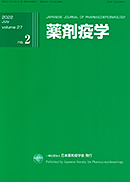Volume 27, Issue 2
Displaying 1-7 of 7 articles from this issue
- |<
- <
- 1
- >
- >|
Review Article
-
Article type: review-article
2022Volume 27Issue 2 Pages 49-59
Published: October 20, 2022
Released on J-STAGE: November 21, 2022
Advance online publication: July 22, 2022Download PDF (546K)
Special Issue on “Safety Monitoring and Related Systems for COVID-19 Vaccine in Japan”
-
Article type: other
2022Volume 27Issue 2 Pages 61
Published: October 20, 2022
Released on J-STAGE: November 21, 2022
Download PDF (131K) -
Article type: editorial
2022Volume 27Issue 2 Pages 62-70
Published: October 20, 2022
Released on J-STAGE: November 21, 2022
Download PDF (2550K) -
Article type: editorial
2022Volume 27Issue 2 Pages 71-77
Published: October 20, 2022
Released on J-STAGE: November 21, 2022
Download PDF (821K) -
Article type: editorial
2022Volume 27Issue 2 Pages 79-87
Published: October 20, 2022
Released on J-STAGE: November 21, 2022
Download PDF (946K) -
Article type: editorial
2022Volume 27Issue 2 Pages 89-95
Published: October 20, 2022
Released on J-STAGE: November 21, 2022
Download PDF (499K)
Proceedings of the 26th Annual Meeting of Japanese Society for Pharmacoepidemiology
-
Article type: oration
2022Volume 27Issue 2 Pages 97-99
Published: October 20, 2022
Released on J-STAGE: November 21, 2022
Download PDF (227K)
- |<
- <
- 1
- >
- >|
